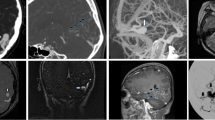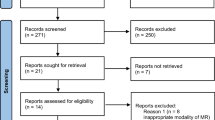Abstract
Introduction
This study aims to review the diagnostic performance of computed tomography (CT) and magnetic resonance imaging (MRI) in symptomatic dural arteriovenous fistula (DAVF).
Methods
EMBASE, PubMed, and Cochrane Library were searched until April 2015 for studies which compared CT, MRI, or both with angiography for the detection of DAVF. The diagnostic performances of MRI and CT were indirectly compared using modality as a covariate in the analysis.
Results
Thirteen studies met our inclusion criteria. MRI had a sensitivity of 0.90 (95 % confidence interval (CI) = 0.83–0.94) and specificity of 0.94 (95 % CI = 0.90–0.96). CT had a sensitivity of 0.80 (95 % CI = 0.62–0.90) and specificity of 0.87 (95 % CI = 0.74–0.94). MRI showed better diagnostic performance than CT (p = 0.02). Contrast medium use and time-resolved MR angiography did not improve MRI diagnostic performance (p = 0.31 and 0.44, respectively).
Conclusion
Both CT and MRI had good diagnostic performance. MRI was better than CT on the detection of symptomatic intracranial dural arteriovenous fistula in the indirect comparison.




Similar content being viewed by others
References
Newton TH, Cronqvist S (1969) Involvement of dural arteries in intracranial arteriovenous malformations. Radiology 93(5):1071–1078. doi:10.1148/93.5.1071
Cognard C, Gobin YP, Pierot L, Bailly AL, Houdart E, Casasco A, Chiras J, Merland JJ (1995) Cerebral dural arteriovenous fistulas: clinical and angiographic correlation with a revised classification of venous drainage. Radiology 194(3):671–680. doi:10.1148/radiology.194.3.7862961
Chaichana KL, Coon AL, Tamargo RJ, Huang J (2012) Dural arteriovenous fistulas: epidemiology and clinical presentation. Neurosurg Clin N Am 23(1):7–13. doi:10.1016/j.nec.2011.09.001
Cha KC, Yeon JY, Kim GH, Jeon P, Kim JS, Hong SC (2013) Clinical and angiographic results of patients with dural arteriovenous fistula. J Clin Neurosci 20(4):536–542. doi:10.1016/j.jocn.2012.02.053
Kaufmann TJ, Huston J 3rd, Mandrekar JN, Schleck CD, Thielen KR, Kallmes DF (2007) Complications of diagnostic cerebral angiography: evaluation of 19,826 consecutive patients. Radiology 243(3):812–819. doi:10.1148/radiol.2433060536
Tsai LK, Jeng JS, Wang HJ, Yip PK, Liu HM (2004) Diagnosis of intracranial dural arteriovenous fistulas by carotid duplex sonography. J Ultrasound Med : Off J Am Inst Ultrasound Med 23(6):785–791
Tsai LK, Liu HM, Lu CJ, Jeng JS, Yip PK (2005) Carotid duplex sonography in the follow-up of intracranial dural arteriovenous fistulae. AJNR Am J Neuroradiol 26(3):625–629. doi:10.1159/000118374
Tsai L-K, Jeng J-S, Yip P-K (2008) Ultrasonography in intracranial dural arteriovenous fistula. J Med Ultrasound 16(1):57–64. doi:10.1016/s0929-6441(08)60006-5
Shin EJ, Lalwani AK, Dowd CF (2000) Role of angiography in the evaluation of patients with pulsatile tinnitus. Laryngoscope 110(11):1916–1920. doi:10.1097/00005537-200011000-00028
Mossa-Basha M, Chen J, Gandhi D (2012) Imaging of cerebral arteriovenous malformations and dural arteriovenous fistulas. Neurosurg Clin N Am 23(1):27–42. doi:10.1016/j.nec.2011.09.007
Moher D, Liberati A, Tetzlaff J, Altman DG (2009) Preferred reporting items for systematic reviews and meta-analyses: the PRISMA statement. Ann Intern Med 151(4):264–269. doi:10.1371/journal.pmed.1000097, w264
Liberati A, Altman DG, Tetzlaff J, Mulrow C, Gøtzsche PC, Ioannidis JPA, Clarke M, Devereaux PJ, Kleijnen J, Moher D (2009) The PRISMA statement for reporting systematic reviews and meta-analyses of studies that evaluate healthcare interventions: explanation and elaboration. BMJ 339:b2700. doi:10.1136/bmj.b2700
Whiting PF, Rutjes AW, Westwood ME, Mallett S, Deeks JJ, Reitsma JB, Leeflang MM, Sterne JA, Bossuyt PM (2011) QUADAS-2: a revised tool for the quality assessment of diagnostic accuracy studies. Ann Intern Med 155(8):529–536. doi:10.7326/0003-4819-155-8-201110180-00009
Reitsma JB, Glas AS, Rutjes AW, Scholten RJ, Bossuyt PM, Zwinderman AH (2005) Bivariate analysis of sensitivity and specificity produces informative summary measures in diagnostic reviews. J Clin Epidemiol 58(10):982–990. doi:10.1016/j.jclinepi.2005.02.022
Dietz RR, Davis WL, Harnsberger HR, Jacobs JM, Blatter DD (1994) MR imaging and MR angiography in the evaluation of pulsatile tinnitus. AJNR Am J Neuroradiol 15(5):879–889
Hirai T, Korogi Y, Hamatake S, Ikushima I, Sugahara T, Sigematsu Y, Higashida Y, Takahashi M (1998) Three-dimensional FISP imaging in the evaluation of carotid cavernous fistula: comparison with contrast-enhanced CT and spin-echo MR. Am J Neuroradiol 19(2):253–259
Noguchi K, Melhem ER, Kanazawa T, Kubo M, Kuwayama N, Seto H (2004) Intracranial dural arteriovenous fistulas: evaluation with combined 3D time-of-flight MR angiography and MR DIGITAL SUBTRACTION ANGIOGRAPHY. Am J Roentgenol 182(1):183–190. doi:10.2214/ajr.182.1.1820183
Farb RI, Agid R, Willinsky RA, Johnstone DM, Terbrugge KG (2009) Cranial dural arteriovenous fistula: diagnosis and classification with time-resolved MR angiography at 3T. AJNR Am J Neuroradiol 30(8):1546–1551. doi:10.3174/ajnr.A1646
Pekkola J, Kangasniemi M (2011) Posterior fossa dural arteriovenous fistulas: diagnosis and follow-up with time-resolved imaging of contrast kinetics (TRICKS) at 1.5T. Acta Radiol 52(4):442–447. doi:10.1258/ar.2011.100433
Bink A, Berkefeld J, Wagner M, You SJ, Ackermann H, Lorenz MW, Senft C, du Mesnil de Rochemont R (2012) Detection and grading of dAVF: prospects and limitations of 3T MRI. Eur Radiol 22(2):429–438. doi:10.1007/s00330-011-2268-2
Shweel M, Hamdy B (2013) Diagnostic utility of magnetic resonance imaging and magnetic resonance angiography in the radiological evaluation of pulsatile tinnitus. Am J Otolaryngol - Head Neck Med Surg 34(6):710–717. doi:10.1016/j.amjoto.2013.08.001
Kim E, Kim JH, Choi BS, Jung C, Lee DH (2014) MRI and MR angiography findings to differentiate jugular venous reflux from cavernous dural arteriovenous fistula. Am J Roentgenol 202(4):839–846
Deuschl C, Goricke S, Gramsch C, Ozkan N, Lehnerdt G, Kastrup O, Ringelstein A, Wanke I, Forsting M, Schlamann M (2015) Value of DSA in the diagnostic workup of pulsatile tinnitus. PLoS ONE 10(2):e0117814. doi:10.1371/journal.pone.0117814
Lee CW, Huang A, Wang YH, Yang CY, Chen YF, Liu HM (2010) Intracranial dural arteriovenous fistulas: diagnosis and evaluation with 64-detector row CT angiography. Radiology 256(1):219–228. doi:10.1148/radiol.10091835
Narvid J, Do HM, Blevins NH, Fischbein NJ (2011) CT angiography as a screening tool for dural arteriovenous fistula in patients with pulsatile tinnitus: feasibility and test characteristics. AJNR Am J Neuroradiol 32(3):446–453. doi:10.3174/ajnr.A2328
Zhao PF, Pamier A, Xian JF, Liang XH, Yan F, Du W, Lu H, Wang ZC (2013) Role of computed tomographic angiography in the evaluations of dural arteriovenous fistulas with pulsatile tinnitus as initial symptom. Zhonghua Yi Xue Za Zhi 93(33):2622–2626
Jang J, Schmitt P, Kim BY, Choi HS, Jung SL, Ahn KJ, Kim I, Paek M, Kim BS (2014) Non-contrast-enhanced 4D MR angiography with STAR spin labeling and variable flip angle sampling: a feasibility study for the assessment of dural arteriovenous fistula. Neuroradiology 56(4):305–314. doi:10.1007/s00234-014-1336-0
Josephson CB, White PM, Krishan A, Al-Shahi Salman R (2014) Computed tomography angiography or magnetic resonance angiography for detection of intracranial vascular malformations in patients with intracerebral haemorrhage. Cochrane Database Syst Rev 9:Cd009372. doi:10.1002/14651858.CD009372.pub2
Kobayashi A, Al-Shahi Salman R (2014) Prognosis and treatment of intracranial dural arteriovenous fistulae: a systematic review and meta-analysis. Int J Stroke : Off J Int Stroke Soc 9(6):670–677. doi:10.1111/ijs.12337
Ma J, Li H, You C, Huang S, Ma L, Ieong C (2012) Accuracy of computed tomography angiography in detecting the underlying vascular abnormalities for spontaneous intracerebral hemorrhage: a comparative study and meta-analysis. Neurol India 60(3):299–303. doi:10.4103/0028-3886.98515
Madani G, Connor SE (2009) Imaging in pulsatile tinnitus. Clin Radiol 64(3):319–328. doi:10.1016/j.crad.2008.08.014
Sismanis A (2011) Pulsatile tinnitus: contemporary assessment and management. Curr Opin Otolaryngol Head Neck Surg 19(5):348–357. doi:10.1097/MOO.0b013e3283493fd8
Aggarwal R, Lloyd S (2012) Pulsatile tinnitus. Otorhinolaryngologist 5(1):7–14
Acknowledgments
We acknowledge the Ministry of Science and Technology support for the Center for Dynamical Biomarkers and Translational Medicine, National Central University, Taiwan (MOST 103-2911-I-008-001).
Author information
Authors and Affiliations
Corresponding author
Ethics declarations
We declare that all human and animal studies have been approved by the internal ethical review board of National Taiwan University Hospital and have therefore been performed in accordance with the ethical standards laid down in the 1964 Declaration of Helsinki and its later amendments. We declare that all patients gave informed consent prior to inclusion in this study.
Conflict of interest statement
We declare that we have no conflict of interest.
Electronic supplementary material
ESM 1
(DOC 37 kb)
Appendix
Appendix
Rights and permissions
About this article
Cite this article
Lin, YH., Lin, HH., Liu, HM. et al. Diagnostic performance of CT and MRI on the detection of symptomatic intracranial dural arteriovenous fistula: a meta-analysis with indirect comparison. Neuroradiology 58, 753–763 (2016). https://doi.org/10.1007/s00234-016-1696-8
Received:
Accepted:
Published:
Issue Date:
DOI: https://doi.org/10.1007/s00234-016-1696-8




